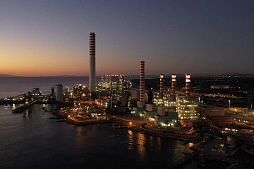After receiving the necessary documents (application form and project presentation), our team will try to review your request as soon as possible, and leading experts will offer the best options for project funding.
The largest coal-fired power plants in the world are complex facilities that require billions of dollars of investment and maintain the energy balance of entire regions.
Tuoketuo Power Station (China)
Tuoketuo Power Station is the largest coal-fired power plant in the world. It is located in Tuoketuo County, Inner Mongolia Autonomous Region, China.This huge power plant was commissioned in November 1995 by Tuoketuo Power Company. The company consists of several major shareholders such as Datang Power, Beijing Power and Huaneng Thermal Power.
On February 25, 2017, after 168 hours of trial operation, the two 660 MW ultra-supercritical units of the fifth phase were officially put into operation, bringing the installed capacity to 5,824 MW and making it the largest coal-fired power plant in the world. At present, the installed capacity of Tuoketuo Power Station reaches 6,720 MW.
Taean Thermal Power Station (South Korea)
Taean Thermal Power Station is a coal-fired power plant in Taean County, Chungcheongnam-do Province, located on the shores of the Yellow Sea.Started in 1995 and expanding to date, this power plant is owned by the Korea Electric Power Corporation (KEPCO) but operated by a subsidiary of the Korea Western Power Company (KOWEPO).
With an installed capacity of about 6.1 GW, Taean was the largest coal-fired power plant in South Korea and one of the largest in the world at the end of 2021. It is generating tens of billions of kilowatt-hours of energy annually. With 31.4 million tons of CO2 emissions in 2018, Taean Thermal Power Station has become the 4th highest carbon emitting power plant on the planet.
A coal gasification plant was built at the site of the power plant, which feeds a 300 MW combined-cycle power plant (CCGT), which was commissioned in August 2016.
The total cost of the coal gasification plant and associated combined cycle power plant is estimated at $1.14 billion.
Dangjin Power Station (South Korea)
Dangjin Power Station is a large coal-fired power plant, located on the coast of the Yellow Sea about 15 km northwest of the city of Dangjin.The power plant is owned by the Korea Electric Power Corporation (KEPCO). Construction work began in the late 1990s, but the station continues to expand. With a current installed capacity of 6,000 MW (after the completion of two large 1,000 MW power units in 2015-2016), it has become one of the most powerful in South Korea. The annual output of the power plant in 2013 exceeded 33 billion kWh.
This facility uses modern technology to improve the efficiency of electricity generation. Units 5-8 use supercritical technology with steam temperatures up to 569°C. Units 9 and 10 already use ultra-supercritical technology with a steam temperature of 600°C, with an efficiency of about 45%.
Taichung Power Plant (Taiwan)
Taichung Power Plant is a coal-fired power plant located in the Longjing District of Taichung City on the west coast of central Taiwan.With a capacity of 5,500 MW, it was ranked as the world's most powerful coal-fired power plant in 2017. The operator is the state-owned Taiwan Power Company, which owns four other coal-fired power plants in addition to the Taichung power plant.
The power plant consists of 10 coal-fired power units, supplemented by 4 small gas turbine power units of 70 MW each. The first four power units with a capacity of 550 MW each were built in 1991 and 1992. Four additional units were added in 1996 and 1997 with a total capacity of 2200 MW. Units 9 and 10 (1100 MW each) were added in 2005 and 2006.
The power plant emits more than 40 million tons of CO2 every year, which is comparable to the total CO2 emissions of some European countries such as Switzerland. In 2016,
Taichung Power Plant provided about 19% of all electricity consumed in Taiwan.

Bełchatow Power Station (Poland)
Bełchatow Power Station is the largest coal-fired power plant in Europe that generates cheap electricity from lignite.The power plant with installed capacity 5,100 MW produces 20% of Poland's electricity. The facility is located in Rogowiec, Lodz Voivodeship.
The power plant emits the most greenhouse gases of any thermal power plant in the world, being highly inefficient in terms of CO2 emissions per unit of electricity generated. In 2018, Bełchatow Power Station emitted 37.6 million tonnes of CO2, more than New Zealand's total emissions.
Bełchatow Power Station operates 12 power units, including 11 obsolete units with a capacity of 370-390 MW each, commissioned in 1981–1988. The station also has one more powerful and efficient power unit with a capacity of 858 MW, commissioned in 2011.
In the second half of 2019, the oldest unit of the power plant, Unit 1, was decommissioned. In 2021, the authorities refused to build a lignite open pit at a nearby field, Zlochev.
The lignite is currently mined from the nearby Bełchatow coal mine and transported to the power plant by conveyor belts. The predicted depletion of coal seams at previously developed deposits and the lack of agreement to develop another deposit make it necessary to close the thermal power plant in the 2030s.
Yonghungdo Power Plant (South Korea)
Yonghungdo Power Plant is a thermal power plant in Incheon Province in South Korea, which is operated by the local company South-East Power Co.The facility uses coal and anthracite as fuel.
Currently, the installed capacity of the power plant exceeds 5080 MW.
The power plant is distinguished from similar facilities by its highly efficient and environmentally friendly equipment, aimed at minimizing carbon emissions. The facility provides about 23% of the electricity consumed in the region and plays a key role in the stable supply of electricity.
Recently, the plant equipment has been enhanced by smart technologies and renewable energy sources, including a solar photovoltaic installation, a small hydropower plant, a range of wind generators and modern energy storage systems.
This contributes to a more sustainable supply of energy to consumers and helps to reduce the environmental footprint.
























